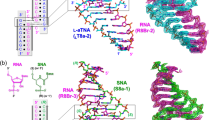Abstract
2′-O,4′-C-methylene-linked ribonucleotide derivatives, named LNA (locked nucleic acid) and BNA (bridged nucleic acid) are nucleic acid analogoues that have shown high-affinity recognition of DNA and RNA, and the employment of LNA oligomers for antisense activity, gene regulation and nucleic acid diagnostics seems promising. Here we show kinetic and thermodynamic results on the interaction of a series of 10 bases long LNA–DNA mixmers, gabmers as well as full length LNA’s with the complementary DNA, RNA and LNA oligonucleotides in the presence and absence of 10 mM Mg2+- ions. Our results show no significant differences in the reaction thermodynamics and kinetics between the LNA species, only a tendency to stronger duplex formation with the gabmer and mixmer. Introduction of a few LNA’s thus may be a better strategy, than using full length LNA’s to obtain an oligonucleotide that markedly increases the strength of duplexes formed with the complementary DNA and RNA.


Similar content being viewed by others
References
Arzumanov A, Walsh AP, Rajwanshi VK, Kumar R, Wengel J, Gait MJ (2001) Inhibition of HIV-1 Tat-dependent trans activation by steric block chimeric 2′-O-methyl–LNA oligoribonucleotides. Biochemistry 40:14645–14654
Braasch DA, Corey DR (2001) Locked nucleic acid (LNA): fine-tuning the recognition of DNA and RNA. Chem Biol 8:1–7
Brown T, Brown DJS (1991) Modern machine-aided methods of oligodeoxyribonucleotide synthesis. In: Eckstein F (ed) Oligonucleotides analogues. Oxford University Press, Oxford, pp. 1–24
Christensen U, Jacobsen N, Rajwanshi VK, Wengel J, Koch T (2001) Stopped-flow kinetics of locked nucleic acid (LNA)-oligonucleotide duplex formation: studies of LNA–DNA and DNA–DNA interactions. Biochem J 354:481–484
Freier SM, Altmann K-H (1997) The ups and downs of nucleic acid duplex stability: structure-stability studies on chemically-modified DNA–RNA duplexes. Nucleic Acids Res 25:4429–4443
Herdewijn P (1999) Conformationally restricted carbohydrate-modified nucleic acids and antisense technology. Biochim Biophys Acta 1489:167–179
Koshkin AA, Singh SK, Nielsen P, Rajwanshi VK, Kumar R, Meldgaard M, Olsen CE, Wengel J (1998) LNA (locked nucleic acids): synthesis of the adenine, cytosine, guanine, 5-methylcytosine, thymine and uracil bicyclonucleoside monomers, oligomerization, and unprecedented nucleic acid recognition. Tetrahedron 54:3607–3630
Kurreck J, Wyszko E, Gillen C, Erdmann VA (2002) Design of antisense oligonucleotides stabilized by locked nucleic acids. Nucleic Acids Res 30:1911–1918
Obika S, Nanbu D, Hari Y, Morio K-I, In Y, Ishida T, Imanishi T (1997) Synthesis of 2′-O,4′-C-methyleneuridine and -cytidine. Novel bicyclic nucleosides having a fixed C3’-endo sugar puckering. Tetrahedron Lett 38:8735–8738
Obika S, Nanbu D, Hari Y, Moroi JA K, Doi T, Imanishi T (1998) Stability and structural features of the duplexes containing nucleoside analogues with a fixed N-type conformation, 2′-O,4′-C-methyleneribonucleosides. Tetrahedron Lett 39:5401–5404
Singh SK, Nielsen P, Koshkin AA, Wengel J (1998) LNA (locked nucleic acids): synthesis and high-affinity nucleic acid recognition. Chem Commun 4:455–456
Uhlmann E, Peyman A (1990) Antisense oligonucleotides: a new therapeutic principle. Chem Rev 90:543–584
Vester B, Wengel J (2004) LNA (Locked Nucleic Acid): High-Affinity Targeting of Complementary RNA and DNA. Biochemistry 43(42):13233–13241
Wahlestedt C, Salmi P, Good L, Kela J, Johnsson T, Hökfelt T, Broberger C, Porreca F, Lai J, Ren K, Ossipov M, Koshkin A, Jakobsen N, Skouv J, Ørum H, Jacobsen MH, Wengel J (2000) Locked nucleic acids (LNA): a novel, efficacious and non-toxic oligonucleotide component for antisense studies. Proc Natl Acad Sci U. S. A. 97:5633–5638
Author information
Authors and Affiliations
Corresponding author
Rights and permissions
About this article
Cite this article
Christensen, U. Thermodynamic and Kinetic Characterization of Duplex Formation between 2′-O, 4′-C-Methylene-modified Oligoribonucleotides, DNA and RNA. Biosci Rep 27, 327–333 (2007). https://doi.org/10.1007/s10540-007-9056-x
Published:
Issue Date:
DOI: https://doi.org/10.1007/s10540-007-9056-x




